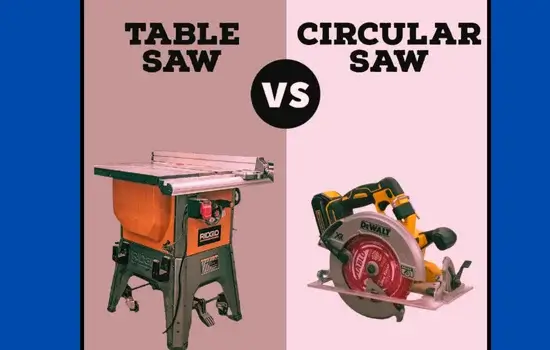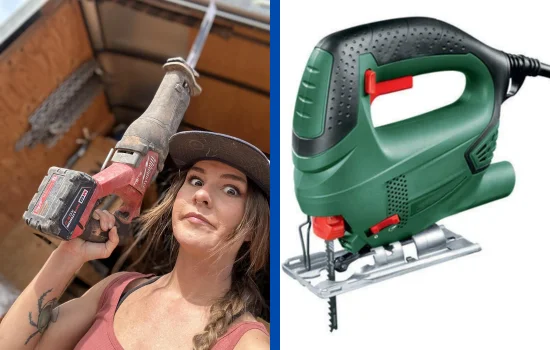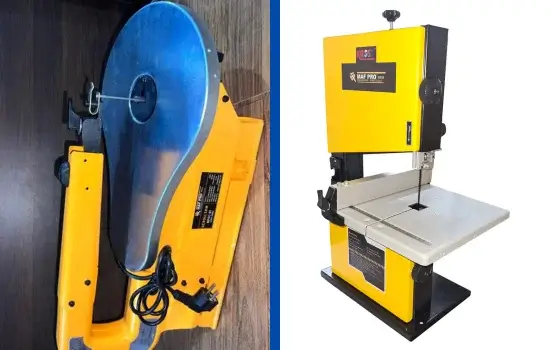When working on woodworking or metalworking projects, choosing the right saw is essential. Two popular saws often compared are the chop saw and the miter saw. While both saws may look similar, their functions, precision levels, and applications differ significantly. Understanding their unique capabilities will help you make the best choice for your specific needs.
In this article, we’ll examine the key differences between a chop saw and a miter saw, diving deep into their uses, cutting capacities, portability, safety features, and ideal applications.
Quick Definitions of Chop Saw and Miter Saw
Chop Saw
A chop saw is a high-powered, fixed saw used primarily for making straight, 90-degree cuts. Designed to handle tough materials like metal and masonry, chop saws are often equipped with abrasive discs rather than toothed blades, providing the power necessary for heavy-duty work.
Miter Saw
A miter saw, on the other hand, is known for its versatility in making angled cuts. It pivots on an arm, allowing for precise angle adjustments, which makes it ideal for woodworking tasks like cutting trim and moldings. Some miter saws also offer bevel cutting for compound angles.
Key Differences Between Chop Saw and Miter Saw
| Feature | Chop Saw | Miter Saw |
|---|---|---|
| Primary Function | Straight cuts (usually 90 degrees) | Angled cuts, including miters and bevels |
| Applications | Metalworking, masonry, heavy-duty work | Woodworking, framing, trim, detailed cuts |
| Cutting Motion | Downward chop | Pivot and chop |
| Blade Type | Abrasive disc for metal cutting | Toothed blade for wood |
| Angle Adjustability | No, fixed 90-degree cuts | Yes, adjustable angles |
| Portability | Generally heavy, stationary | Lightweight, easy to move |
| Cutting Depth | Deep cuts on tough materials | Limited to wood or light materials |
| Precision | Lower precision, more rugged cuts | High precision, ideal for finish work |
| Safety Features | Blade guard | Blade guard, lock-off switch, sometimes lasers |
| Cost | Mid-range to high | Mid-range to high, with many variations |
Detailed Comparison of Chop Saw and Miter Saw
1. Purpose and Applications
- Chop Saw: Primarily used for heavy-duty, straight cuts, chop saws are ideal for cutting hard materials like metal, masonry, and plastic. With their abrasive discs and powerful motors, chop saws can handle thick metal pipes, rods, and other challenging materials. This makes them the go-to choice for construction sites, metal workshops, and fabrication jobs where rugged cutting is required.
- Miter Saw: Miter saws are designed for precision work, especially on wood. Their versatility in making angled cuts (miter cuts) and bevel cuts (angled cuts along the thickness) makes them perfect for tasks like trimming, framing, and molding. Woodworkers, carpenters, and DIY enthusiasts commonly use miter saws for projects that demand precise and decorative cuts.
2. Cutting Capacity and Types of Cuts
- Chop Saw: Chop saws are straightforward tools focused on making quick, powerful 90-degree cuts. The blade moves straight down onto the material, and while they offer excellent power, they lack adjustability for angle or bevel cuts. This limitation in cut types makes them less versatile, but their power ensures they can cut through materials that a miter saw cannot handle.
- Miter Saw: Miter saws excel in versatility. They can make several types of cuts, including crosscuts (straight cuts across the width of a piece), miter cuts (angled cuts for joints), and bevel cuts. Some miter saws even combine miter and bevel capabilities in a single cut, known as a compound cut. This flexibility is invaluable for complex woodworking projects.
3. Blade Types and Materials
- Chop Saw: A chop saw generally uses an abrasive disc rather than a toothed blade. This disc is specifically designed for cutting metal or masonry, allowing the saw to slice through dense materials without wearing down too quickly. However, the abrasive blade can generate sparks, requiring extra safety measures when used on-site or indoors.
- Miter Saw: Miter saws are equipped with toothed blades, specifically made for cutting wood and some soft metals like aluminum. The fine-toothed blade ensures a clean, precise cut, which is crucial for woodworking projects that require a high level of finish. Some blades are interchangeable, enabling the saw to cut through other materials, but miter saws are typically not designed for heavy metals.
4. Angle Adjustability and Precision
- Chop Saw: Angle adjustability is one of the major limitations of a chop saw. These saws are built for 90-degree cuts only, making them less suited for projects that require precision at different angles. However, for applications where only straight cuts are needed, chop saws offer power and speed.
- Miter Saw: A miter saw’s ability to adjust angles and make precise cuts is one of its defining features. Most models can pivot up to 45 degrees in either direction and often include preset detents at common angles (e.g., 45° and 90°). Dual bevel miter saws allow for angle cuts in both directions without rotating the workpiece, providing an advantage in both speed and precision.
5. Portability and Workspace Requirements
- Chop Saw: Due to their robust build and heavy-duty nature, chop saws tend to be heavier and less portable. They’re often designed for stationary use in workshops or construction sites, where stability is paramount. However, compact chop saw models are available, although they’re still heavier than miter saws.
- Miter Saw: Miter saws are generally more portable and designed to be easily transported. They can be used in various settings, including workshops, home garages, and outdoor job sites. Many models also come with handles or compact designs, making them ideal for professionals who need to move between job sites frequently.
6. Safety Features
- Chop Saw: Chop saws are usually equipped with a blade guard, which provides a level of safety by covering the abrasive disc when it’s not in use. However, chop saws generate a lot of heat and sparks, making them riskier for indoor use without proper ventilation. Gloves and safety glasses are a must when operating a chop saw, particularly for metal cutting.
- Miter Saw: Miter saws come with several safety features, including a blade guard and a lock-off switch that prevents accidental startups. Some high-end miter saws also include laser guides that improve cutting accuracy by indicating the cutting line on the material. The toothed blades are typically less dangerous than the abrasive discs on a chop saw, especially when cutting softer materials like wood.
7. Cost Considerations
- Chop Saw: Chop saws are generally in the mid-range to high price category, depending on their power and size. Metal-specific chop saws with higher RPMs and durable abrasive discs can be more costly. For professionals in construction or metalworking, however, a chop saw’s durability justifies the investment.
- Miter Saw: Miter saws also vary in price, with models ranging from affordable options to high-end, feature-rich saws. Single bevel miter saws are typically less expensive, while dual bevel and sliding miter saws are more costly due to their added functionality. Woodworkers who require precision and versatility will find the investment worthwhile.
Pros and Cons of Chop Saw and Miter Saw
Chop Saw Pros:
- High power for cutting hard materials like metal and masonry
- Durable and effective for heavy-duty tasks
- Straightforward operation, ideal for straight cuts
Chop Saw Cons:
- Limited to 90-degree cuts, lacks angle versatility
- Generates sparks and heat, requiring safety precautions
- Heavier and less portable
Miter Saw Pros:
- Precise angle and bevel cutting capabilities
- Versatile and ideal for woodworking and finish work
- Lightweight and portable, suitable for job sites
Miter Saw Cons:
- Limited cutting capacity on harder materials like metal
- Generally less powerful than chop saws
- Can be costly, especially for dual bevel or sliding models
Choosing the Right Tool: Chop Saw vs. Miter Saw
When deciding between a chop saw and a miter saw, consider the nature of your projects:
- If your work involves heavy materials like metal, masonry, or hard plastics, a chop saw is the right choice. Its power and straightforward design make it perfect for straight cuts on tough materials. However, keep in mind the limitations in versatility for angle cuts.
- If your projects involve woodworking or require precise angle cuts, a miter saw will serve you better. It is built for accuracy, flexibility, and ease of use, especially on wood and light materials. For woodworking, framing, and decorative cuts, a miter saw provides the adaptability needed to complete complex projects.
Conclusion
Both chop saws and miter saws have their unique strengths and are valuable tools in any workshop. By understanding the specifics of each tool, including their cutting capabilities, precision, and ideal applications, you can make an informed decision on which saw best fits your needs.


